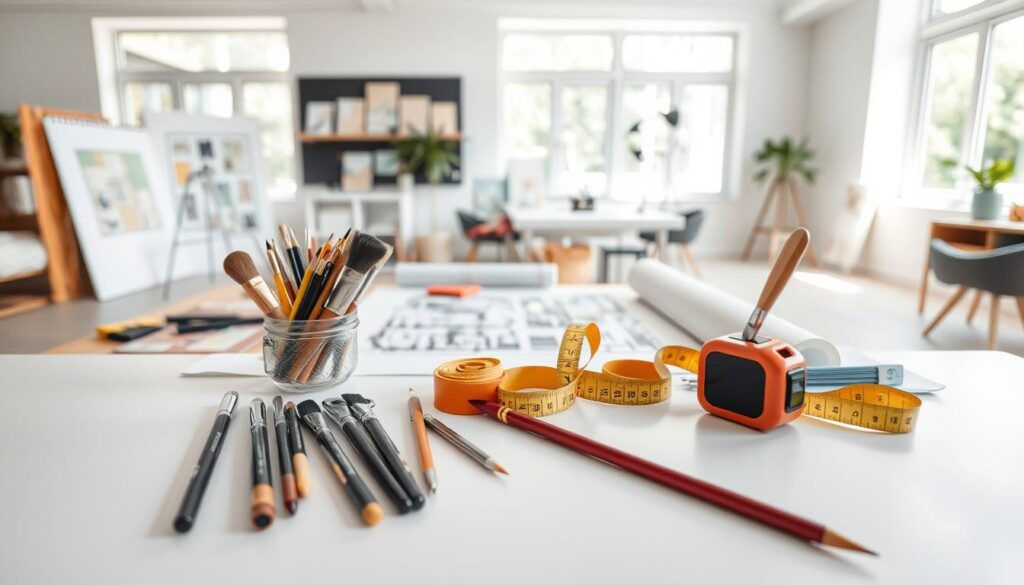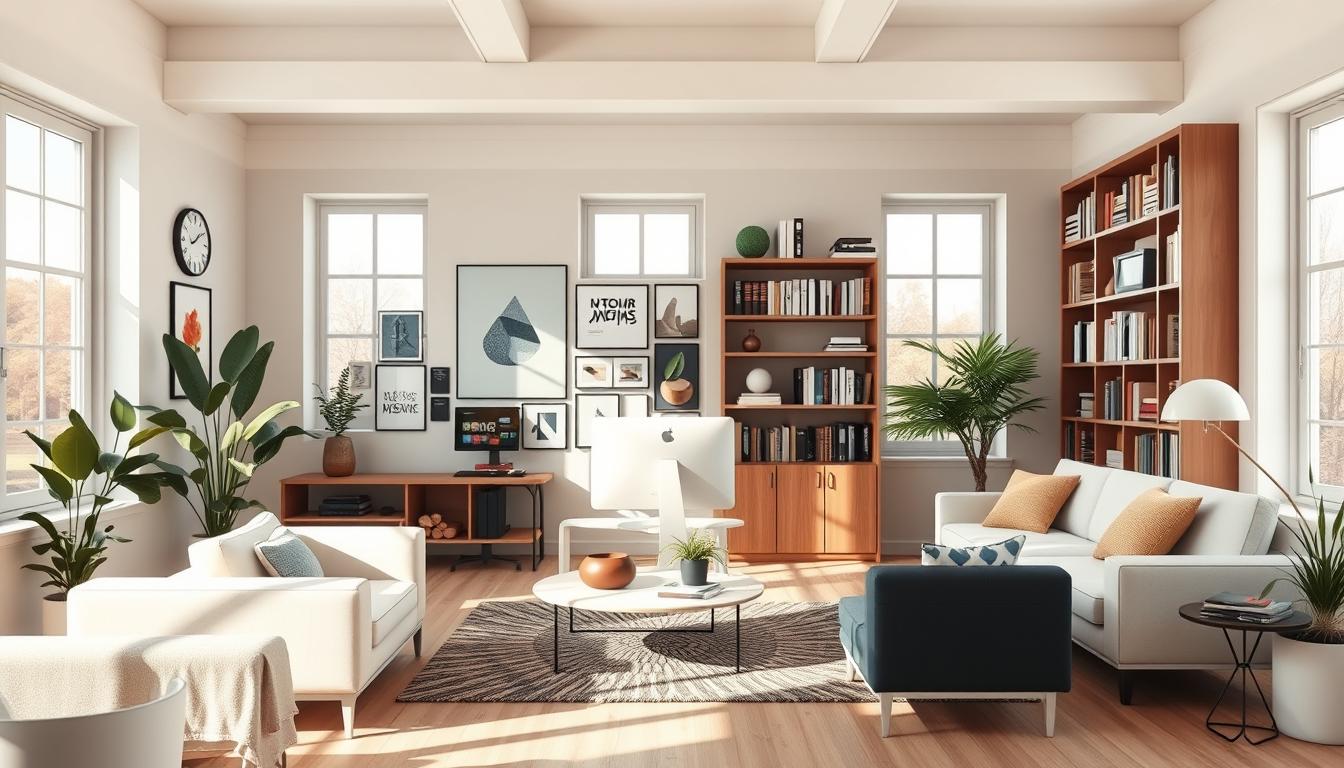Did you know the global interior design market is growing by 4.5% every year? More people are taking on DIY projects and making their living spaces unique. This means there’s a big need for good interior design certification programs.
We’re going to show you the top home interior design programs out there. They’ll help you make your dream home a reality, easily and accurately.
Key Takeaways
- Overview of the best home interior design software
- Features to look for in interior design certification programs
- Tips for choosing the right program for your needs
- Benefits of using home interior design programs
- How to get started with your chosen program
Understanding Home Interior Design Programs
If you’re thinking about a career in interior design, it’s key to know about home interior design programs. These programs teach you the skills and knowledge needed to succeed.
Definition and Scope of Interior Design
Interior design is more than just decorating. It’s about making spaces both functional and beautiful. You’ll learn about design principles like balance and harmony. You’ll also get to know interior design tools like AutoCAD and SketchUp.
Interior design covers many areas, including homes, offices, and hotels. Designers need to understand what clients want and manage projects well. They also have to stay within budgets.
- Residential interior design focuses on homes and apartments.
- Commercial interior design involves offices, retail spaces, and more.
- Hospitality interior design is about creating inviting spaces in hotels and restaurants.
The Importance of Interior Design Education
Getting an education in interior design is vital. Accredited interior design programs teach you the basics of design, color, and space planning. They also cover the latest design software and technologies.
These programs help you think critically, be creative, and solve problems. They prepare you for the challenges of the industry.
- Develops technical skills necessary for the profession.
- Fosters creativity and innovation in design.
- Prepares students for industry-specific challenges.
By joining a good interior design program, you can start your career on the right path.
Types of Home Interior Design Programs
Home interior design education has grown, offering many program types for those who want to design homes. It’s key to know the differences to choose wisely.
Certificate Programs
Certificate programs are great for quick learning in specific areas like interior decorating or space planning. They’re perfect for beginners or those wanting to improve their skills.
Associate Degree Programs
Associate degree programs last two years and cover the basics of design, color theory, and interior design practices. They help students get ready for entry-level jobs.
Bachelor’s Degree Programs
Bachelor’s degree programs are more in-depth, teaching everything from design history to technical skills. Many include virtual interior design programs and digital tools in their curriculum.
Online vs. In-Person Programs
Choosing between online and in-person programs depends on your learning style and life. Online programs are flexible, perfect for those with busy lives or who prefer best online interior design courses. In-person programs offer hands-on learning and direct interaction with teachers and peers.
| Program Type | Duration | Key Features |
|---|---|---|
| Certificate | Several months | Focused on specific skills, short duration |
| Associate Degree | 2 years | Foundational education, prepares for entry-level positions |
| Bachelor’s Degree | 4 years | Comprehensive education, covers a wide range of topics |
Think about your career goals and learning style when picking a program. Whether it’s a certificate, associate, or bachelor’s degree, or online or in-person, there’s a fit for everyone.
Key Features to Look for in a Program
When searching for the best home interior design program, look for certain qualities. These qualities set apart the best programs from the rest. It’s important to consider several key features to ensure a comprehensive education.
Curriculum Overview
A good interior design program has a solid curriculum. It should cover a wide range of topics. This includes design principles, the latest trends, and technologies in interior design.
The curriculum should also include courses on top interior design software. This ensures students know how to use industry-standard tools.
“The curriculum should be comprehensive, incorporating both theoretical knowledge and practical skills,” says Jane Smith, a renowned interior designer. “It’s crucial for students to gain hands-on experience with various interior design tools.”
Accreditation and Recognition
Accreditation is key when choosing an interior design program. It shows the program meets quality standards and is recognized by the industry. Look for programs accredited by reputable agencies.
- Check if the program is accredited by a recognized accrediting agency.
- Verify if the program is recognized by professional interior design associations.
Faculty Expertise
The expertise of the faculty is also crucial. Instructors should have a strong background in interior design. They should have experience in teaching and professional practice.
They should be able to guide on using top interior design software and other industry tools.
https://www.youtube.com/watch?v=dceRdf6Bw-k&pp=ygUII2FyY2hpYWk%3D
By focusing on these key features, students can make an informed choice. This ensures they find a program that meets their needs and prepares them for a successful career.
Top Accredited Home Interior Design Schools
Choosing the right interior design program is key. We’ll look at top schools known for their quality.
The New York School of Interior Design
The New York School of Interior Design is famous for its detailed curriculum and expert teachers. Accredited by the Council for Interior Design Accreditation (CIDA), it offers programs for those starting their design career.
Savannah College of Art and Design
The Savannah College of Art and Design (SCAD) is a top choice for interior design. It focuses on both theory and practical skills. SCAD gets students ready for a career in interior design.
Rhode Island School of Design
The Rhode Island School of Design (RISD) is known for its tough programs, including interior design. RISD’s program boosts creativity and technical skills. This prepares graduates for success in the field.
| Institution | Accreditation | Program Highlights |
|---|---|---|
| The New York School of Interior Design | CIDA Accredited | Comprehensive curriculum, experienced faculty |
| Savannah College of Art and Design | CIDA Accredited | Theoretical foundations, practical skills |
| Rhode Island School of Design | CIDA Accredited | Rigorous academic program, fosters creativity and technical proficiency |
These schools are leaders in interior design education. They give students the tools to thrive in this competitive field.
Online Home Interior Design Programs
Online home interior design programs are a flexible way to start a career in interior design. With technology improving and more people needing designers, these programs are getting more popular. Students from all over the world are choosing them.
Benefits of Online Learning
One big plus of online interior design programs is how flexible they are. Students can do their work whenever they want. This helps them fit their studies into their busy lives.
Key benefits include:
- Accessibility from anywhere with an internet connection
- Self-paced learning
- Reduced costs compared to traditional on-campus programs
Online programs also give students access to lots of resources and tools. This helps them learn and grow in a fun and effective way.
Popular Online Programs to Consider
Many schools offer top-notch online interior design programs. Some of the most notable options are:
- Programs offered by The New York School of Interior Design
- Savannah College of Art and Design (SCAD) online degrees
- Rhode Island School of Design (RISD) online courses
These programs aim to give students the skills they need to do well in interior design.
Flexible Scheduling Options
Online interior design programs often have flexible schedules. This is great for students who are busy or have other commitments. It lets them learn at their own pace.
Flexible scheduling can include:
- Part-time study options
- Accelerated programs for those who want to finish fast
- Self-directed learning paths that let students learn as they go
These flexible options help students reach their goals in interior design. It makes it easier for them to succeed.
Skills Developed in Interior Design Programs
Interior design programs teach many skills. These include technical skills, creative vision, and soft skills for professional growth. It’s clear these programs aim to make well-rounded professionals.
Technical Skills
Technical skills are key in interior design education. Students learn to use interior design tools and home decor software like AutoCAD and SketchUp. These tools help them share their ideas clearly.
- Proficiency in design software like Adobe Creative Suite
- Understanding of building codes and regulations
- Knowledge of materials and finishes

Creative Skills
Creative skills are also vital. They let designers innovate and share their unique views. Through projects, students learn to think creatively and solve problems.
- Development of personal design style
- Ability to conceptualize and visualize design concepts
- Innovative problem-solving skills
Soft Skills for Success
Interior design programs also focus on soft skills. These are important for working well with clients, teaming up with others, and managing projects.
- Effective communication and presentation skills
- Project management and organizational skills
- Client relationship management
By covering these areas, interior design programs prepare graduates. They’re not just skilled in design but also ready for the professional world.
Career Opportunities After Completion
After finishing a home interior design program, you can look at many career paths. The field of interior design is wide, with lots of chances to specialize and grow.
We’ll look at the different jobs you can get. This includes working on homes and businesses, and special areas within the field.
Residential Interior Designer Roles
Residential interior designers help homeowners make their living spaces better. They do things like:
- Talking with clients to know what they want
- Picking out furniture, fixtures, and materials
- Creating design plans and presentations
- Watching the installation of design elements
They work on many kinds of projects. This can be anything from single-family homes to apartments and condos.
Commercial Interior Design Careers
Commercial interior designers work on spaces for businesses. This includes offices, restaurants, and stores. Their job is to:
- Get to know the business’s needs and its people
- Design spaces that are useful, safe, and follow rules
- Choose materials and finishes that fit the client’s budget and taste
- Work with contractors and other experts during building
They need to know about building codes, making spaces accessible, and green practices.
Specializations within Interior Design
Interior designers can focus on different areas. Some examples are:
| Specialization | Description |
|---|---|
| Sustainable Design | Creates spaces that are good for the environment using green materials and methods. |
| Universal Design | Makes spaces that everyone can use, no matter their age or ability. |
| Kitchen and Bath Design | Focuses on making kitchens and bathrooms work well and look good. |
These special areas let designers become experts in certain fields. This helps them stand out in the job market.
Choosing a career in interior design lets you use your creativity and skills. You can make spaces that improve people’s lives.
Potential Salary Expectations in Interior Design
Exploring interior design, it’s key to know about salary expectations. The money you can make depends on your education, experience, and what area you specialize in.
Average Salary of Interior Designers
The salary for interior designers changes based on where you work, how long you’ve been doing it, and the industry. In the U.S., interior designers can make between $50,000 and over $90,000 a year on average.
Residential designers might make less than those in commercial design. Using top interior design software can also boost your earnings by making you more efficient and versatile.
Factors Influencing Salary Levels
Many things can affect how much interior designers earn. Getting a degree from a accredited interior design program can give you an advantage in finding a job.
Where you live also matters, with cities usually paying more than rural areas. Your experience level is another factor, with more experienced designers earning more.
In summary, salaries in interior design can vary, but knowing what affects them can guide your career choices. Focus on education, gain experience, and keep up with industry tools to succeed financially.
Networking and Professional Development
To succeed in interior design, we must focus on networking and growing professionally. Building a strong network and improving our skills are key to success.
The Power of Networking
Networking in interior design helps us meet potential employers, collaborators, and mentors. It opens doors to new opportunities, like jobs and projects that boost our portfolios. By going to industry events, joining groups, and using online forums, we build a strong network that helps our careers.
Good networking is about making real connections, not just collecting contacts. For example, meeting experienced designers can give us valuable insights and job market advice.

Key Organizations and Associations
Many organizations and associations are important in interior design. These include:
- The American Society of Interior Designers (ASID)
- The National Kitchen and Bath Association (NKBA)
- The Interior Design Society (IDS)
These groups offer many benefits, like education, networking, and tools for growth. By joining, we stay updated on trends, best practices, and new interior design tools and virtual interior design programs.
| Organization | Benefits | Target Audience |
|---|---|---|
| ASID | Continuing education, networking, professional development | Interior designers, industry professionals |
| NKBA | Industry insights, design education, business resources | Kitchen and bath designers, industry partners |
| IDS | Professional networking, industry events, design resources | Interior designers, architects, industry suppliers |
Internship Opportunities
Internships are key for growing in interior design. They give us hands-on experience and let us apply what we’ve learned. Internships also help us build our network and understand the industry better.
“Internships are invaluable for gaining practical experience and making industry connections. They often lead to job offers and provide a competitive edge in the job market.”
By taking advantage of internships, we can improve our skills, expand our network, and boost our chances of success in interior design.
The Role of Technology in Interior Design Education
Technology has changed how we learn and use design principles in interior design. It’s key to know how tech is changing the design world.
Technology is a must-have in interior design education. It offers many resources and chances to improve learning. Design software and virtual reality are big advancements in this area.
Use of Design Software
Design software is now a big part of learning interior design. Tools like Autodesk Revit, SketchUp, and Adobe Creative Suite help students make detailed designs. They also get ready for the tech needs of the industry.
Using design software in education has many benefits. It makes designs more precise and lets students share their ideas better. It also makes the design process faster and more efficient.
Virtual Reality in Interior Design Training
Virtual reality (VR) is also changing interior design education. VR lets students dive into their designs, feeling them in a real way. This helps them understand their designs better and see how they’ll work.
VR in training has many benefits. It helps students get a better feel for space and design. It also makes learning more fun and interactive.
By using these technologies, interior design programs give students a solid education. They’re ready for the modern design world.
Challenges in Home Interior Design Programs
Home interior design programs come with their own set of challenges. These can be both creative and practical. It’s important to know what students and professionals face in these programs.
Balancing Creativity and Practicality
One big challenge is finding a balance between creativity and practicality. Students need to think creatively and come up with new designs. But they also have to think about the budget, how things work, and what the client wants.
Creativity is key in interior design, helping designers make unique and beautiful spaces. But, this creativity must be balanced with practicality. This ensures the designs are doable and meet the clients’ needs.
“The best designs are those that marry creativity with functionality, creating spaces that are not only beautiful but also livable.”
Staying Updated with Industry Trends
Another challenge is keeping up with the latest trends in the industry. The world of interior design is always changing. New materials, technologies, and design ideas come out all the time.
- Following industry leaders and influencers on social media
- Attending design conferences and workshops
- Participating in online forums and discussions
By keeping up with the latest trends, designers can make sure their work is current and relevant. This gives them an edge in the competitive design world.
Tips for Choosing the Right Program for You
Finding the right home interior design program can be tough. There are so many choices out there. Start by thinking about what you want to achieve and what you need from a program.
Personalized Approach
Look at the program’s curriculum, the skills of the teachers, and if it’s accredited. Choose programs that match your career goals.
Campus Experience
Visiting campuses and attending open houses is a great idea. It lets you see the program’s vibe and facilities firsthand. This can help you decide better.
Industry Insights
Talking to industry experts is also helpful. They can give you real advice and share their experiences. This can help you pick the right program for you.
By carefully looking at these points and focusing on accredited programs, you can find the best home interior design program for your career.



